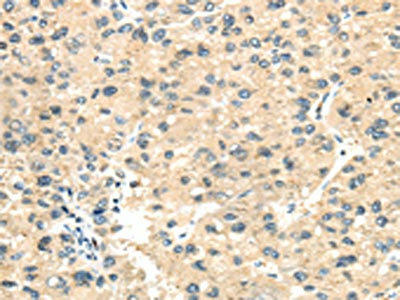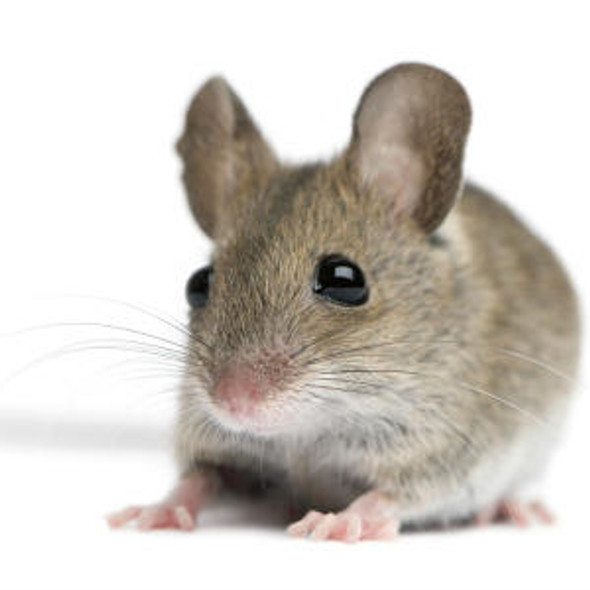Description
| Antibody Name: | THBS1 Antibody (PACO20774) |
| Antibody SKU: | PACO20774 |
| Size: | 50ul |
| Host Species: | Rabbit |
| Tested Applications: | ELISA, IHC |
| Recommended Dilutions: | ELISA:1:2000-1:5000, IHC:1:25-1:100 |
| Species Reactivity: | Human, Mouse |
| Immunogen: | Synthetic peptide of human THBS1 |
| Form: | Liquid |
| Storage Buffer: | -20°C, pH7.4 PBS, 0.05% NaN3, 40% Glycerol |
| Purification Method: | Antigen affinity purification |
| Clonality: | Polyclonal |
| Isotype: | IgG |
| Conjugate: | Non-conjugated |
 | The image on the left is immunohistochemistry of paraffin-embedded Human liver cancer tissue using PACO20774(THBS1 Antibody) at dilution 1/20, on the right is treated with synthetic peptide. (Original magnification: x200). |
| Background: | The protein encoded by this gene is a subunit of a disulfide-linked homotrimeric protein. This protein is an adhesive glycoprotein that mediates cell-to-cell and cell-to-matrix interactions. This protein can bind to fibrinogen, fibronectin, laminin, type V collagen and integrins alpha-V/beta-1. This protein has been shown to play roles in platelet aggregation, angiogenesis, and tumorigenesis. |
| Synonyms: | thrombospondin 1 |
| UniProt Protein Function: | THBS1: Adhesive glycoprotein that mediates cell-to-cell and cell-to-matrix interactions. Binds heparin. May play a role in dentinogenesis and/or maintenance of dentin and dental pulp. Ligand for CD36 mediating antiangiogenic properties. Belongs to the thrombospondin family. |
| UniProt Protein Details: | Protein type:Motility/polarity/chemotaxis; Inhibitor Chromosomal Location of Human Ortholog: 15q15 Cellular Component: extracellular matrix; extracellular space; cell surface; sarcoplasmic reticulum; endoplasmic reticulum; endoplasmic reticulum lumen; fibrinogen complex; extracellular region; secretory granule; external side of plasma membrane Molecular Function:heparin binding; identical protein binding; laminin binding; calcium ion binding; integrin binding; protein binding; proteoglycan binding; fibroblast growth factor binding; transforming growth factor beta binding; phosphatidylserine binding; fibronectin binding; low-density lipoprotein binding; glycoprotein binding Biological Process: extracellular matrix organization and biogenesis; activation of MAPK activity; response to magnesium ion; negative regulation of fibrinolysis; response to glucose stimulus; cell adhesion; cell cycle arrest; positive regulation of macrophage activation; response to drug; platelet activation; negative regulation of interleukin-12 production; positive regulation of chemotaxis; positive regulation of blood vessel endothelial cell migration; response to testosterone stimulus; negative regulation of cell-matrix adhesion; negative regulation of blood vessel endothelial cell migration; response to unfolded protein; positive regulation of angiogenesis; response to mechanical stimulus; negative regulation of endothelial cell proliferation; peptide cross-linking; regulation of cGMP metabolic process; response to calcium ion; response to progesterone stimulus; negative regulation of apoptosis; positive regulation of blood coagulation; positive regulation of translation; negative regulation of fibroblast growth factor receptor signaling pathway; negative regulation of antigen processing and presentation of peptide or polysaccharide antigen via MHC class II; negative regulation of caspase activity; behavioral response to pain; platelet degranulation; positive regulation of tumor necrosis factor biosynthetic process; positive regulation of transforming growth factor-beta1 production; protein amino acid O-linked glycosylation; cell migration; chronic inflammatory response; negative regulation of focal adhesion formation; positive regulation of transforming growth factor beta receptor signaling pathway; engulfment of apoptotic cell; post-translational protein modification; positive regulation of protein kinase B signaling cascade; negative regulation of angiogenesis; cellular protein metabolic process; negative regulation of dendritic cell antigen processing and presentation; response to hypoxia; immune response; sprouting angiogenesis; blood coagulation; positive regulation of phosphorylation; positive regulation of cell migration |
| NCBI Summary: | The protein encoded by this gene is a subunit of a disulfide-linked homotrimeric protein. This protein is an adhesive glycoprotein that mediates cell-to-cell and cell-to-matrix interactions. This protein can bind to fibrinogen, fibronectin, laminin, type V collagen and integrins alpha-V/beta-1. This protein has been shown to play roles in platelet aggregation, angiogenesis, and tumorigenesis. [provided by RefSeq, Jul 2008] |
| UniProt Code: | P07996 |
| NCBI GenInfo Identifier: | 117949802 |
| NCBI Gene ID: | 7057 |
| NCBI Accession: | P07996.2 |
| UniProt Secondary Accession: | P07996,Q15667, Q59E99, A8K6H4, B4E3J7, B9EGH6, |
| UniProt Related Accession: | P07996 |
| Molecular Weight: | 120,148 Da |
| NCBI Full Name: | Thrombospondin-1 |
| NCBI Synonym Full Names: | thrombospondin 1 |
| NCBI Official Symbol: | THBS1 |
| NCBI Official Synonym Symbols: | TSP; THBS; TSP1; TSP-1; THBS-1 |
| NCBI Protein Information: | thrombospondin-1; thrombospondin-1p180 |
| UniProt Protein Name: | Thrombospondin-1 |
| Protein Family: | Thrombospondin |
| UniProt Gene Name: | THBS1 |
| UniProt Entry Name: | TSP1_HUMAN |
| Antibodies | ELISA Kits |
| Anti-THBS1 Antibody (CAB2125) | Human TSP-1 (Thrombospondin-1) CLIA Kit (HUES00905) |
| Anti-THBS1 Antibody (CAB16985) | Human Thrombospondin-1 (THBS1) ELISA Kit |
| Secondary Antibody |
| Anti-HRP Goat Anti-Rabbit IgG (H+L) Antibody (CABS014) |
| Recommended Products |
| Anti-FITC Goat Anti-Rabbit IgG (H+L) Antibody (CABS011) |
| Anti-HRP-conjugated Beta Actin Antibody (CABC028) |






